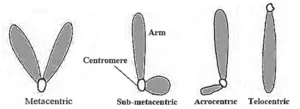Chromosomes exhibit diverse structures classified into four types based on the centromere’s position:
1. Metacentric:
In metacentric chromosomes, the centromere is centrally located, resulting in arms of nearly equal length. This configuration gives the chromosome a characteristic ‘V’ shape during anaphase.
2. Sub-metacentric:
Characterized by a centromere positioned away from the middle, sub-metacentric chromosomes have one arm shorter than the other. This asymmetry imparts an ‘L’ shape to the chromosome during anaphase.
3. Acrocentric:
Acrocentric chromosomes feature a centromere situated near one end, causing one arm to be significantly shorter than the other. This structural arrangement imparts a distinctive ‘J’-shaped appearance during anaphase.
4. Telocentric:
In telocentric chromosomes, the centromere is located at the chromosome’s tip, resulting in a rod-shaped structure. Telocentric chromosomes have only one arm, contributing to their unique appearance.
 Chromosomes are categorized into autosomes and allosomes based on their functions. Autosomes, responsible for determining body characteristics, are somatic chromosomes. In contrast, allosomes, also known as sex chromosomes, play a pivotal role in determining the individual’s sex.
Chromosomes are categorized into autosomes and allosomes based on their functions. Autosomes, responsible for determining body characteristics, are somatic chromosomes. In contrast, allosomes, also known as sex chromosomes, play a pivotal role in determining the individual’s sex.